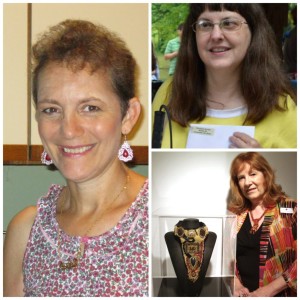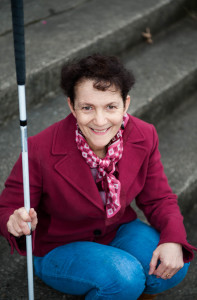I met Amy via an online Retinitis Pigmentosa support group, and we instantly connected. Reading this post, I think you’ll see why! She writes an awesome blog and has a memoir that I’m looking forward to reading. This is one of my favorite posts because it discusses the spectrum of blindness and how many people with vision loss do not appear so.
By Amy L. Bovaird
 Look at the picture. Who would you guess the blind one is?
Look at the picture. Who would you guess the blind one is?
You might think it’s the second photo because there is a little part of a cane sticking up. The truth is … each one of us in the photo is blind.
Blindness can’t be measured on a set of scales with a needle, one pointing to BLIND and the other SIGHTED. Yet, it’s often believed that it’s like that. Either you can see or you can’t. So when onlookers see an individual using a white cane, many times the thought that accompanies it is, “that person can’t see anything.”
But then the same blind person looks at a watch, checks messages on a cell phone, looks both ways when crossing the street, makes eye contact with the onlooker, orders off a table menu, walks around a number of barriers while dragging the cane behind, or simply smiles at him or herself in a mirror.
You can see! You’re faking it. You just want attention. You must want a free bus pass. You’re playing tricks. Snea-ky! Hey, look this way. And the most famous response is … But you don’t LOOK blind!
People have often voiced these thoughts aloud to me – much later, of course when they can laugh at their misconceptions. Sometimes strangers even voice these thoughts out loud. While it might seem strange, some vision-impaired people may unconsciously follow these same fallacies. I don’t look blind. AM I faking it? Are people going to think I am? I struggled with it certainly. That’s one reason it is so hard to pick up a cane and use it.
Those who are not familiar with blindness often have a certain idea in their minds of what a blind person looks like. When I ask them what that is, their response might be, “Someone with thick glasses.” The answers vary; sometimes silence follows.
The truth is, you can’t tell if someone is blind by looking.
I’ve had people try to “catch” me by snapping their fingers quickly to see if I notice the movement. It’s equivalent to “Look at me! Gotcha!”
I wonder why people want to catch us. What’s in it for them?
When I trained in Orientation and Mobility, I learned that “blindness” encompasses a whole continuum of varying degrees of sight to no sight. A lot of people are visually-impaired and no one even knows their struggle because they have enough vision to get around without a cane or a guide dog. But the struggle is real.
Yes, some people can make eye contact. Some can’t.
Some can look you straight in the eye one moment then turn around and spill a large glass of water the next. There’s a gap in their peripheral, or side, vision. Some can see where you’re standing, but not your hands. So you go to shake a hand and the person stands there unaware. “What a snob,” the thought is. Another gap.
In Erie, Pennsylvania, where I live, there are about 290,000 citizens. 15 % of those people are legally blind. That means there are about 43,500 people who cannot see what a typical person should be able to see. That’s a lot of people!
I never minded people thinking I was clumsy or air-headed. It was an easy blame. It was much harder to admit I couldn’t see. Maybe you know someone who is having some struggles. Maybe it’s his or her vision. Be kind. And if you see someone with a cane, don’t “test” them. Don’t “wonder.” It’s hard to pick up a cane, believe me. If I wanted attention or a free bus pass, I could solve that in other ways.
Today’s truth: blindness is a continuum with a large span between legally blind and completely blind. There is no one look to being blind. – you can tweet this.
Do you know anyone who is visually-impaired or blind? If you could ask them one question about their vision, what would it be?
Amy Bovaird is an educator, an inspirational speaker and author of the bestselling memoir, Mobility Matters: Stepping Out in Faith. Although Amy suffers from a dual —progressive vision and hearing loss—she continues to enjoy running, hiking and traveling. She also supports local and national animal rescue organizations. Amy blogs about international travel and the challenges she faces as she loses more vision and hearing. But more importantly, she shares the lessons God reveals to her through her difficulties. You can read about her experiences at http://amybovaird.com
Other ways to connect with Amy:
Amazon kindle, paperback and Large Print
Audio sample (book coming soon!)


If you’re any level of vision impaired in PA, I have a feeling you’re familiar with David DeNotaris from the PA Commision for the Blind. He was my former 4th grade student back when I was a teacher in a sighted classroom.
Thanks, Joy!
I am grateful for this education. Really well done…..Awesome human experiences in kindness and courage.
Kevin Kuhn
Thanks for an excellent blog. I have RP and wish there was more public understanding about being partially sighted. I sometimes wear a badge, which is excruciating in some ways, but at least informs strangers.
Oh Amy! You summarized the daily social challenges so well. Thank you for your efforts in educating others. The psychological pain each of us sight impaired people through because of ignorance is complicated, but you made it real.
Thank you,
Ann
Yes, she did a beautiful job showing this!